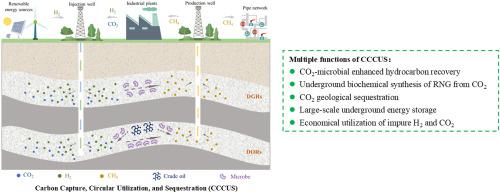Carbon circular utilization and sequestration in depleted hydrocarbon reservoirs: Towards a carbon-neutral China
IF 3.6
引用次数: 0
Abstract
The technology of carbon dioxide (CO2) enhanced hydrocarbon recovery is favored over other Carbon Capture, Utilization, and Sequestration (CCUS) methods for achieving the “double carbon” goal in China due to its ability to sequester CO2 geologically while enhancing the recovery rates of oil and gas resources. However, current technologies face significant challenges, such as limited recovery enhancement capacity, as well as high costs and low efficiency in carbon utilization and sequestration. To address these issues, an innovative carbon-negative technology termed Carbon Capture, Circular Utilization, and Sequestration (CCCUS) is proposed. This technology integrates CO2-microbial enhanced hydrocarbon recovery, CO2 underground bio-methanation, and CO2 sequestration in depleted hydrocarbon reservoirs. Compared to conventional CCUS technologies, CCCUS stands out through both its modes of carbon utilization and the forms in which carbon exists, by cyclically biochemically converting endogenous and exogenous CO2 into renewable natural gas (RNG). A preliminary assessment indicates that CCCUS holds significant developmental potential in China, with 661 million tonnes of CO2 utilized per cycle and 3.47 billion tonnes ultimately sequestered. However, there is a significant lack of research on the core technology of CCCUS, specifically CO2 underground bio-methanation, in China. To bridge this gap and mitigate potential challenges during the development of CCCUS, targeted proposals have been formulated. This paper provides new insights into advancing the development of a circular carbon economy and accelerating the achievement of carbon neutrality in China.

枯竭油气藏碳循环利用与封存:走向碳中和的中国
在中国,二氧化碳(CO2)增强碳氢化合物回收技术比其他碳捕获、利用和封存(CCUS)方法更受青睐,因为它能够在提高油气资源回收率的同时实现二氧化碳的地质封存,从而实现“双碳”目标。然而,目前的技术面临着重大挑战,如提高回收能力有限,以及碳利用和封存成本高、效率低。为了解决这些问题,提出了一种创新的碳负技术,即碳捕获、循环利用和封存(CCCUS)。该技术集成了二氧化碳微生物增强油气采收率、二氧化碳地下生物甲烷化和枯竭油气藏的二氧化碳封存。与传统的CCUS技术相比,CCCUS通过将内源性和外源性二氧化碳循环生物化学转化为可再生天然气(RNG),其碳利用模式和碳存在形式都很突出。初步评估表明,CCCUS在中国具有巨大的发展潜力,每个循环利用6.61亿吨二氧化碳,最终封存34.7亿吨二氧化碳。然而,国内对CCCUS的核心技术,特别是CO2地下生物甲烷化技术的研究非常缺乏。为了弥合这一差距并减轻CCCUS发展过程中的潜在挑战,已经制定了有针对性的建议。本文为推动中国发展循环碳经济、加快实现碳中和提供了新的思路。
本文章由计算机程序翻译,如有差异,请以英文原文为准。
求助全文
约1分钟内获得全文
求助全文

 求助内容:
求助内容: 应助结果提醒方式:
应助结果提醒方式:


